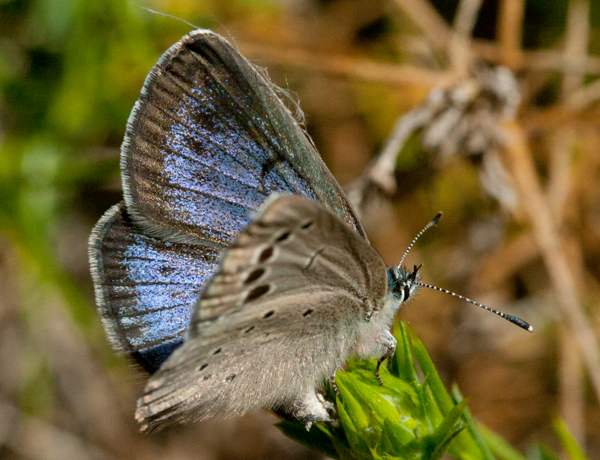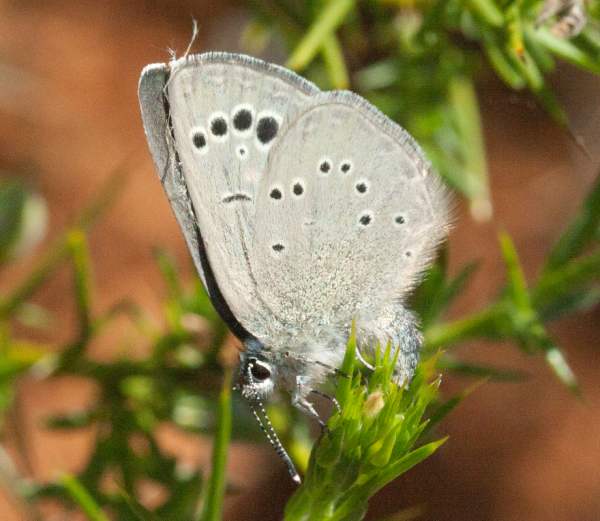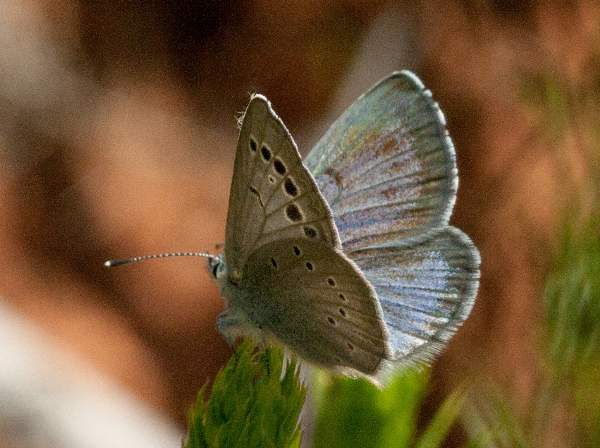Large Blue Butterfly - Maculinea arion (syn. Phengaris arion)
Phylum: Arthropoda - Class: Insecta - Order: Lepidoptera - Family: Lycaenidae

This is the largest of the 'blues' in Britain and also the rarest. In fact it became extinct in 1979 and only hangs on now because of a pioneering reintroduction from continental Europe.
Description
Its large (for a 'blue', that is) size - a wingspan of 38 to 48mm for males and 42 to 52 mm for females - and the characteristic forewing patterning of elongated black dots are all you need to identify with confidence this distinctive butterfly.
Habitat
The Large Blue is a butterfly of warm, dry short-sward grassland where Wild Thyme (and occasionally Wild Marjoram) are present together with colonies of the red ant Myrmica sabuleti.
Distribution
Following successful reintroductions from Sweden, the Large Blue occurs in sites in Gloucestershire, Somerset and Devon. This 'rewilding' conservation initiative was dependent upon careful management of sites not only for the Large Blue butterfly itself but, importantly, for the colonies of the red ant Myrmica sabuleti upon which the butterfly's larvae parasitise during their final instar before pupation. Elsewhere, the Large Blue is found in many parts of central Europe and across Asia to China and Japan.

Lifecycle
These butterflies lay their eggs in June, and the eggs hatch after two or three weeks. The main larval foodplant used by caterpillars of the Large Blue during its first three instars is Wild Thyme Thymus polytrichus. In the fourth instar the caterpillars drop to the ground and, if found by a red ant, imitate an ant larva so that the adult ant isdeceived into carrying the Large Blue caterpillar to its underground nest; there the caterpillars feed parasitically upon ant larvae before pupating in May. The adult butterflies emerge after about three weeks and are seen on the wing from the end of May until early July.

Acknowledgements
This page includes pictures kindly contributed by Rob Petley-Jones.
Studying butterflies and moths...
Excited at the prospect of flyfishing? So are we, and we're pretty sure you would find the Winding River Mystery trilogy of action-packed thrillers gripping reading too. Dead Drift, Dead Cert, and Dead End are Pat O'Reilly's latest river-and-flyfishing based novels, and now they are available in ebook format. Full details on our website here...
Buy each book for just £4.96 on Amazon...
Please Help Us: If you have found this information interesting and useful, please consider helping to keep First Nature online by making a small donation towards the web hosting and internet costs.
Any donations over and above the essential running costs will help support the conservation work of Plantlife, the Rivers Trust and charitable botanic gardens - as do author royalties and publisher proceeds from books by Pat and Sue.
